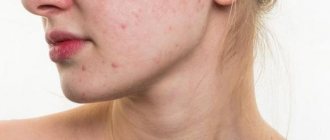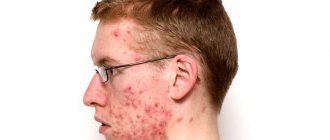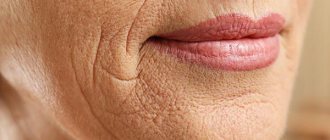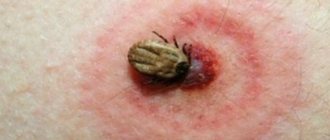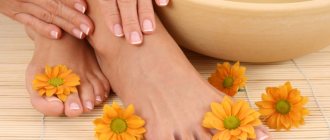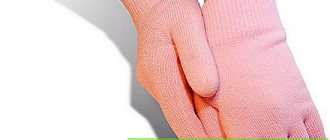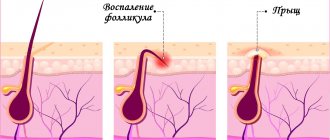The skin around the nose is oily. External reasons
The skin around and inside the nose can peel for many reasons. Among them are:
- unfavorable weather conditions and room temperature;
- lack of vitamins in the body, especially in the spring;
- incorrectly selected or low-quality cosmetics (foundation, powder, cream, foam, wipes);
High temperatures or, conversely, very low temperatures are unfavorable conditions for tissues. Therefore, to prevent peeling, there should be humidifiers in the room. Maintaining an optimal temperature prevents the removal of moisture from cells. Before going outside, the areas around the nose should be moisturized with a cream specially selected for your skin type.
Vitamin deficiency is the main cause of dryness and flaking not only of the area on the wings of the nose, but also of other parts of the body. With a lack of vitamins A, B, E, as well as the microelements selenium, iodine and iron, a feeling of tightness and excessive formation of scales occurs.
Using cosmetic moisturizers for vitamin deficiency is not enough. Requires action on the root cause.
Decorative cosmetics that are incorrectly selected for your skin type or of poor quality can cause not only peeling, but also an allergic reaction. The impact of the components on the cells of the epidermis leads to dehydration and their excessive death in the form of scales.
Dry skin can be avoided if you choose your cosmetics carefully. Pay attention to the composition. The best option is to contain natural ingredients.
Rash near the wings of the nose. Rash under the nose: causes
The appearance of a rash under the nose may be associated with exposure to ultraviolet radiation on the skin, a decrease in the body's immune properties, increased sensitivity to allergens, the use of various creams and ointments, and high sensitivity of the facial skin to negative factors. In addition, there may be internal causes of the formation of a rash, such as pathologies of the digestive system, disruption of the normal functioning of the endocrine system, nervous strain and stress.
Rash under a child's nose
In children, the appearance of pimples in most cases indicates the presence of dermatitis. In such cases, you should contact your pediatrician and visit a dermatologist, especially if the child is less than three years old. You cannot give your baby any medications without a doctor’s prescription.
Non-pathological causes of a rash under the nose in children can be:
- dirt . Children often touch their faces with dirty hands and put various objects into their mouths. This may lead to rashes. If, apart from the rash, there are no symptoms of the disease, then you need to strengthen control over the baby’s hygiene, and lubricate problem areas with baby cream;
- weather conditions . Often, after a walk in windy or frosty weather, a child may develop small pimples or areas of damaged skin. You can cope with them with the help of baby cream, Bepanten, Summed and other similar products.
Rash under the nose in adults
Rashes under the nose, in the area of the nasolabial triangle, are often found in adults. The reason for this is the increased activity of the fat glands in this area. When bacteria enter the pores of the glands, an inflammatory process can begin, which leads to the formation of pimples, blackheads and rashes. However, the causes of a rash under the nose can be not only local; some serious diseases can provoke such a reaction.
The most common cause of acne and rashes near the nose is insufficient hygiene. If you are prone to developing a rash, you should use special products that reduce skin oiliness and have anti-inflammatory and antibacterial effects.
Of the common factors leading to rashes under the nose and on the skin of the face, hormonal imbalance is considered the most common. In women, pimples can occur during pregnancy or during menstruation. Pathologies of the cardiovascular and endocrine systems can also cause a similar reaction.
What are sebaceous filaments
Sebaceous threads are not a defect, but a natural function of the epidermis. Appearing on the surface, sebum forms a lipid barrier that protects the dermis from damage. The main mistake many people make is that they confuse blackheads and sebaceous plugs. Unknowingly, they squeeze out the latter, thereby provoking increased sebum secretion. And this threatens oily skin in the T-zone, the appearance of acne and impaired dermis protection.
Subscribe to our INSTAGRAM account!
Meanwhile, blackheads differ from sebaceous threads both externally and functionally:
1. Blackheads literally protrude above the skin as dark, hard heads, and sebaceous plugs do not stand out in either bright color or hardness.
2. If you squeeze out a blackhead, it will come out as a dark dense mass; if you squeeze out a sebaceous thread, it will come out as a white thin thread with a yellow tint.
3. Blackheads consist of dead skin cells and excess sebum. And sebaceous plugs are an element of protection for our skin.
Fat nose in men. Oily facial skin in men - How to solve the problem
Oily facial skin creates no less problems for men than for women. There are various ways to deal with oily skin problems: anti-oily skin care products, using room temperature water when washing your face, minimal skin friction and other methods. Let's find out which ones.
Cosmetical tools
Sometimes oily shine becomes noticeable in the late afternoon, and the situation gets worse if you are going out somewhere after the end of the working day. You need a rescue product, fortunately, there are many of them on sale. Anti-shine products (mattifying agents) reduce shine using special oil-absorbing particles and ingredients that tighten pores and temporarily reduce their size. They're easy to use: just apply them to problem areas, just like you would apply shaving cream. Mattifying products are good because they produce an instant effect. When the shine appears again, reapply the product. There are also some good mattifying powders available on the market, designed specifically for men, which are very effective, provided you are comfortable using men's cosmetics. Another effective remedy against oily shine are special oil-absorbing wipes - these are thin wipes that remove sebum and oily shine on the face. They are especially useful for teenagers, since the napkins easily fit into the back pocket of trousers and are completely invisible. As a last resort, you can replace them with toilet paper, but this looks less elegant.
Daily care
To get rid of oily skin, men need to exfoliate once or twice a week. This will help clean out the pores and prevent the appearance of pimples, whiteheads and blackheads. You can exfoliate your face with a special cleanser or use your regular cleanser, applying it to the skin in circular motions using a sponge or fine sponge. A sponge or sponge can also help exfoliate the skin of the body, especially those parts of your body that are prone to excessive oiliness, such as the chest and back. Never use a cleanser immediately after shaving, as this will cause redness and irritation to the skin. If you need to shave, apply an exfoliant first, then start shaving. The next step towards getting rid of oily skin is to use a gentle cleanser to wash your face. Men with oily skin need to cleanse their skin at least once a day, but no more than twice. In the morning, wash your face with warm water and cleanser. Apply the product using circular movements to oily areas of the face, usually the forehead, nose, and cheeks. This will rid the skin of dead cells and cleanse the pores of the face. Then rinse your face with warm water. Use oil-free cleansers. It is important that facial skin care products are not made with oils, as this can trigger increased sebum production and the appearance of acne. Face tonic . Using a facial toner is recommended for men with oily skin as the toner removes dirt and oil, as well as any remaining cleanser. But make sure your product is oil-free. The same applies to moisturizer, which should preferably be applied after each face wash. Wet the cotton pad with warm water, then squeeze out the water. Apply a small amount of toner to a cotton pad and sweep it over your forehead, nose and cheekbones. Avoid the chin as the cotton pad can get caught in the stubble. Before going to bed, wash your face with soap and warm water. Use soap intended for oily or normal skin, this will be indicated on the packaging. After washing, wipe your face with toner.
oily skin in men: some tips
Use shower products containing salicylic acid, which helps remove oil and will also help you fight acne that occurs in problem areas: shoulders, neck, back. Avoid touching your face too often during the day. Resting your cheek on your palm or constantly touching your face can clog your pores, which can lead to pimples and blackheads, especially if your skin is naturally oily. And another important factor in solving problems with oily skin is proper nutrition. Stick to foods that are not too sweet and avoid fried foods and fast food items as these stimulate the sebaceous glands and make your skin oilier.
Plastic surgeon Valery Staisupov
December 6, 2020When going under the surgeon’s knife, a person wants to be sure that the result of rhinoplasty will live up to expectations. That is why he tries to foresee everything, not to lose sight of even minor details. Many patients ask me about factors that affect the appearance of a new nose. Frequently asked questions include: Does the thickness of the skin matter, and where does this tissue go after the hump is removed? I will try to answer each of them in as much detail as possible.
What is the significance of the thickness of the skin on the nose?
The tip of the nose with thick skin after rhinoplasty always takes a rounded shape
During the examination of the patient, among other things, the skin of the olfactory organ is assessed, since the result of the upcoming rhinoplasty largely depends on it. The thickness, integrity, and mobility in relation to the main nasal structures are determined.
There are two types of nasal skin: thin and thick. In the first case, the patient after surgery can see the internal sutures that connect the cartilage to each other during surgery. The disadvantage of thin skin is that any hematoma can turn out to be an unevenness. There are some advantages though. The owner of this type has a large choice of the final shape of the nose. It can be made narrow and elegant, depending on the wishes of the patient.
Thick skin also has its disadvantages. The tip of the nose after rhinoplasty always takes on a rounded shape. The size of the operated organ is directly related to the skin's ability to contract. Therefore, it is impossible to give guarantees as to what the width of the nose will be after correction.
As for the benefits of thick skin, it makes almost all irregularities and asymmetries invisible, the tip of the nose becomes soft and solid. In patients with such skin, swelling lasts a little longer, but usually this becomes the only inconvenience during the rehabilitation period.
Patient of Dr. V. Staysupov with thin skin
Regardless of the type of skin on the patient's nose, he can count on a good result from rhinoplasty. You just need to take into account the individual characteristics of the organ being operated on and use them wisely during the intervention.
We have figured out the importance of skin thickness during rhinoplasty. It remains to find out where the excess of this tissue, formed as a result of certain surgical procedures, goes.
Patient of Dr. V. Staysupov with thick skin
What happens to the skin after the hump is removed?
One of the most common nasal defects is a hump. If it is small, after plastic surgery the skin is evenly distributed over the back of the nose. But what happens when the defect is of an impressive size? Immediately after its removal, excess skin is formed - it gathers in folds. 20-30 minutes after the surgeon finishes working on the tip of the nose and its back, the skin begins to contract.
This fabric behaves similarly to a latex glove. As the hump grows, the skin on the back of the nose stretches. After surgery to eliminate this defect, it shrinks and fits a new, straight nose. The speed of this process depends on the age of the person being operated on. The younger the patient, the higher the ability of elastin fibers to contract. Older people need more time to recover.
In the photo on the right, guess who has thick skin and who has thin skin!
Oily facial skin folk remedies. Skin cleansers
- Lemon Oily skin can be wiped several times a day with a cotton swab soaked in lemon juice, or just a piece of lemon.
- You can wipe your face with a mixture of lemon juice and water (1 teaspoon of juice per 1/4 cup of water).
- Rubbing with lemon juice is recommended to reduce the oiliness of the facial skin. Before going to bed, lubricate your face with lemon juice and rinse with water in the morning.
- To wash without soap, add lemon juice - 1.5 - 2 tablespoons of juice per 1 liter of water. For normal skin - 1 tablespoon.
In the morning it is useful to wash your face with a decoction of calendula, St. John's wort, bodan, mint, string, sage, wormwood. These plants reduce oily skin and give it a velvety feel. From this collection you can make not only a decoction, but also an alcohol tincture, which before use is diluted with water in a ratio of 1:5, and wiped on the face like a lotion.
- Salt procedures If there are comedones (blackheads, inflamed and non-inflamed) on the skin, and acne, so-called salt procedures are recommended. Use a cotton swab soaked in soap suds and sprinkled with fine table salt for 1 - 2 minutes. wipe your face in a circular motion. Salt crystals destroy blockages in the sebaceous ducts and promote better release of sebum from the glands. Therefore, after salt cleansing, it is necessary to disinfect the skin with alcohol lotions. Then the face is washed with water. These procedures can be done 2 - 3 times a week.
- Nourishing lotion To the beaten white of 1 egg, add dropwise half a glass of cologne, camphor alcohol and quince juice. It is recommended to cleanse oily, porous facial skin with a cotton swab dipped in this lotion. After the procedure, it becomes soft, smooth, and velvety.
- Quince Finely chop the quince, pour a glass of vodka or 20% alcohol, leave for 7-10 days, strain. Wipe your face with the resulting lotion or soak a thin layer of cotton wool and apply a mask (except for the eyes, nostrils and mouth) for 15 - 20 minutes. When the cotton wool dries, re-moisten it with the infusion. After completing the procedure, rinse your face with warm water. Recommended for oily, porous skin.
- Aloe Oily, porous, acne-prone skin can be wiped with canned aloe juice. For preservation, add 1 part alcohol to 4 parts juice. Store in a cool, dark place in a stoppered bottle.
- Orange Grate a whole orange with its peel, pour half a glass of vodka over the resulting pulp, leave for 5-7 days in a dark place, then strain, squeeze out the mixture and add 1 teaspoon of glycerin. It is recommended to wipe oily, porous skin every evening with this lotion.
A lotion made from equal parts of watermelon and peach juices is used to wipe the face for any skin type.
- Birch Pour crushed dried bark of young birch with cold water in a ratio of 1:5, leave for 8 hours, then strain. The infusion is used to wipe oily, acne-prone skin and has an antimicrobial, anti-inflammatory and tonic effect.
- Oak bark For wiping and lotions for oily, porous skin prone to acne, make a 5-10% decoction of oak bark. Put 10-20 g of crushed bark in an enamel bowl, add a glass of water, cover the bowl with a lid. Boil the mixture over low heat or a water bath for 30 minutes, strain and add boiled water to the original volume. The procedure helps reduce sebum secretion, tightens pores, and makes the skin firm and elastic.
- Strawberries To cleanse oily skin, pour 1/2 cup of mashed wild strawberries into a glass of vodka, leave for 1 month, strain, mix half and half with water. Wipe your face at any convenient time.
- For oily skin, it is recommended to wipe your face with a mixture of equal amounts of fresh cabbage and cucumber juices.
- For oily, porous skin, 10 - 15 minutes. Before washing, wipe your face well with sauerkraut juice.
- For oily skin and sweating of the face in the summer, rubbing with an infusion of coltsfoot leaves and yarrow herb, mixed in equal parts, has a good effect. Brew a tablespoon of the mixture with a glass of boiling water, strain the infusion after 7-8 hours.
The skin around the mouth and nose peels. Prevention
To prevent the appearance of rashes around the mouth, proper prevention is important. You should strengthen the body's defenses, spend more time in the fresh air, do exercises, and harden yourself.
Nutrition is of great importance. It is necessary to exclude fast food, smoked foods, carbonated drinks, sweets, citrus fruits, and baked goods. The diet should be enriched with fresh herbs, vegetables and fruits collected in the region of residence, fermented milk products, and cereals. To improve the health of all organs and systems, it is useful to drink at least 2 liters of clean water per day.
To prevent fungal, bactericidal and viral infections, you should regularly wash your hands, use individual towels and adhere to other personal hygiene rules.
You can prevent the development of allergies by limiting contact with allergens. To do this, you need to adjust your diet, protect your hands with gloves when working with household chemicals, and use natural care products and mineral cosmetics.
Peeling around the mouth is a common and often easily solvable problem caused by poor diet and care. However, sometimes, when the skin around the mouth peels, tightness and irritation appear, this is an alarming symptom of unpleasant diseases of the gastrointestinal tract or problems with hormones, and in this case it is worth visiting a doctor.
The reasons why the skin around the mouth peels can also be related to dermatitis or vitamin deficiency.
Wide nose rhinoplasty
Preparatory stage
The patient needs to undergo a series of examinations. Standard set includes:
- General analysis of urine and blood
- Blood chemistry
- Infectious panel (primarily HIV, hepatitis)
- Fluorography
- ECG
- Computed tomography of the nose
7-10 days before surgery you need to:
- Stop drinking alcohol and cigarettes
- Do not take blood thinning medications
- Avoid direct sunlight
Before performing the operation, the plastic surgeon creates a computer model of the upcoming changes and demonstrates it to the patient. After agreeing and confirming the selected operation scheme, the date for the procedure itself is set.
Operation
90% of nose reshaping operations are performed under general anesthesia.
The duration is no more than 2 hours.
During the operation, the plastic surgeon makes incisions and gradually removes the soft tissue. The cartilage and skeletal system are not affected. At the end, about 5 stitches are applied, which are removed after a week.
After the recovery period, dramatic differences are visible. You can see photos of patients before and after rhinoplasty
Very oily facial skin hormones. Oily skin
Oily skin will not cause any special problems if you take care of it correctly and regularly. Moreover, with proper care, oily skin retains a youthful and fresh appearance much longer than dry skin. In people with oily skin, it begins to appear later. However, in youth, during the period of hormonal changes in the body, oily skin is often manifested by a pronounced greasy sheen, enlarged pores, and comedones and pustular elements may appear on it. Often, not only the skin of the face, but also the head, chest, and back are characterized by increased oiliness. Approximately 10% of people with oily skin continue to have such problems after the age of 30.
Oily skin is one of four variants of the norm (normal and combination skin are also possible). If the oily skin becomes pathological, it is seborrhea (when not only the production of sebum is increased, but its qualitative composition is also changed: the content of unsaturated fatty acids is insufficient, its bactericidal properties are reduced). If pustular rashes regularly appear against the background of seborrhea, this is already.
Oily skin and hormonal levels
Oily skin is characterized by increased activity of the sebaceous glands, which is largely regulated by sex hormones. This is due to the fact that in youth, during the period of highest levels of sex hormones, the skin is oilier. As you age, both hormone levels and skin oiliness decrease. The sebaceous glands react to changes in hormonal levels in all people, but the degree of their sensitivity varies from person to person and is determined genetically. Therefore, with the same level of hormones, different people will have different skin oiliness.
Women may experience pronounced changes in skin oiliness depending on the phase of the menstrual cycle during pregnancy.
The main causes of comedones
In a healthy body, the amount of fat secreted by the sebaceous glands is automatically regulated. The hormonal system is responsible for this. Sebum is evenly distributed over the surface of the skin, playing the role of natural lubrication, protecting against mechanical damage and drying out.
In the event of disturbances or malfunctions in its operation, the skin of the face instantly reacts:
- sebum secretion occurs unevenly;
- the speed and volume of its production increase;
- the release of fat from the pores becomes more difficult (keratinized particles of the epidermis act as a “buffer”, closing the ducts);
- a significant part of the fat remains in the pores, gradually hardens and darkens.
The main factors causing the appearance of comedones include:
NOTE!
To quickly get rid of blackheads, acne and pimples, as well as to rejuvenate your facial skin, we recommend that you familiarize yourself with this effective remedy .
Find out more...
- some chronic diseases for the treatment of which potent drugs (antibiotics, etc.) were used;
- unbalanced diet, non-compliance with drinking regime;
- severe stress;
- incorrectly selected or irregular facial care;
- heredity;
- increased testosterone levels in men;
- changes in hormonal levels in women;
- increased ambient humidity;
- unfavorable environmental conditions (polluted atmosphere, insufficient water purification, etc.)
